2018 MERCEDES-BENZ CLA COUPE automatic transmission
[x] Cancel search: automatic transmissionPage 125 of 326
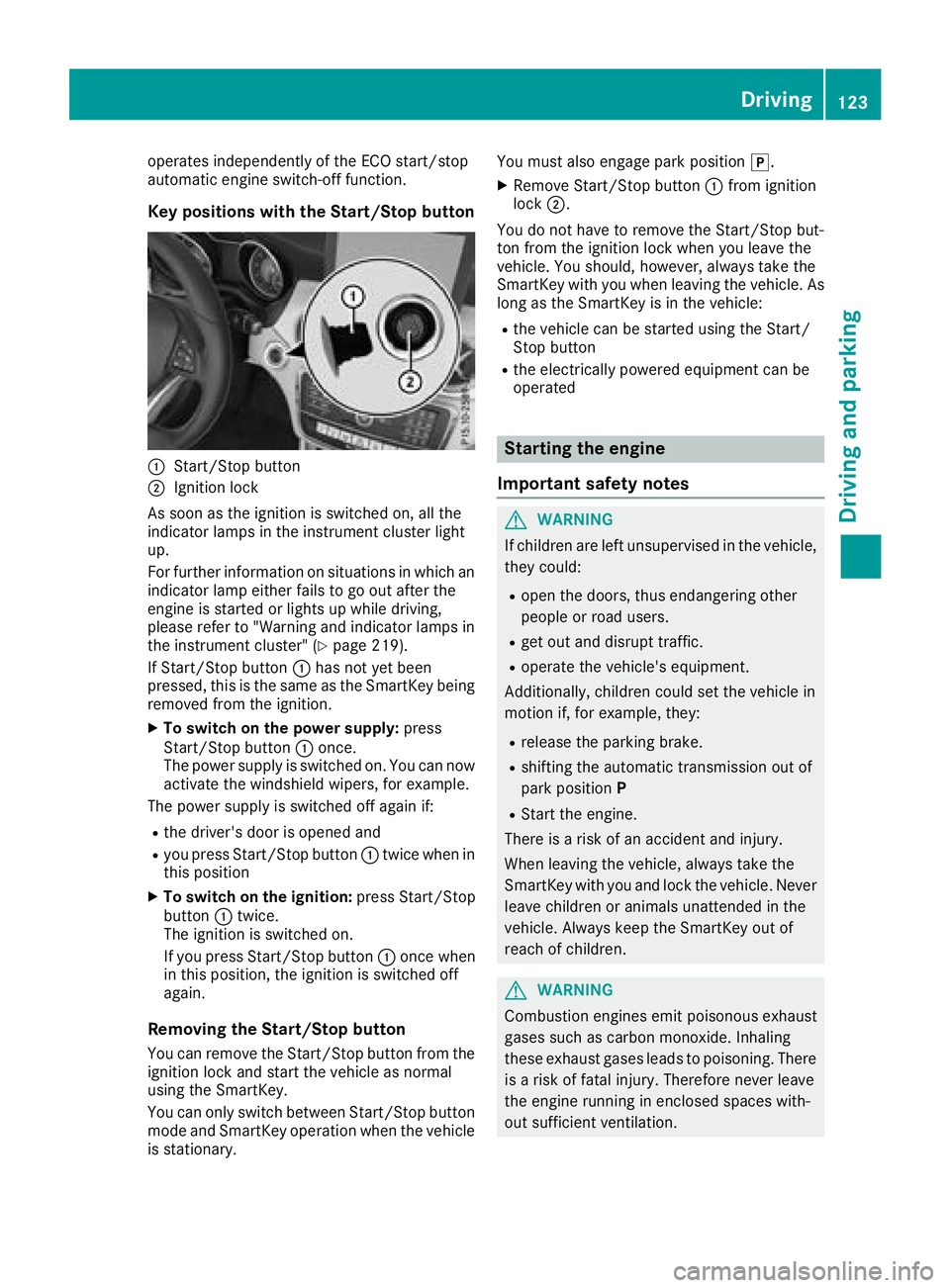
operates independently of the ECO start/stop
automatic engine switch-off function.
Key positions with the Start/Stop button
:Start/Stop button
;Ignition lock
As soon as the ignition is switched on, all the
indicator lamps in the instrument cluster light
up.
For further information on situations in which an indicator lamp either fails to go out after the
engine is started or lights up while driving,
please refer to "Warning and indicator lamps in
the instrument cluster" (
Ypage 219).
If Start/Stop button :has not yet been
pressed, this is the same as the SmartKey being
removed from the ignition.
XTo switch on the power supply: press
Start/Stop button :once.
The power supply is switched on. You can now
activate the windshield wipers, for example.
The power supply is switched off again if:
Rthe driver's door is opened and
Ryou press Start/Stop button :twice when in
this position
XTo switch on the ignition: press Start/Stop
button :twice.
The ignition is switched on.
If you press Start/Stop button :once when
in this position, the ignition is switched off
again.
Removing the Start/Stop button
You can remove the Start/Stop button from the ignition lock and start the vehicle as normal
using the SmartKey.
You can only switch between Start/Stop button
mode and SmartKey operation when the vehicle
is stationary. You must also engage park position
j.
XRemove Start/Stop button:from ignition
lock ;.
You do not have to remove the Start/Stop but-
ton from the ignition lock when you leave the
vehicle. You should, however, alwayst ake the
SmartKey with you when leaving the vehicle. As
long as the SmartKey is in the vehicle:
Rthe vehicle can be started using the Start/
Stop button
Rthe electrically powered equipment can be
operated
Starting the engine
Important safety notes
GWARNING
If children are left unsupervised in the vehicle,
they could:
Ropen the doors, thus endangering other
people or road users.
Rget out and disrupt traffic.
Roperate the vehicle's equipment.
Additionally, children could set the vehicle in
motion if, for example, they:
Rrelease the parking brake.
Rshifting the automatic transmission out of
park position P
RStart the engine.
There is arisk of an accident and injury.
When leaving the vehicle, alwayst ake the
SmartKey with you and lock the vehicle. Never
leave children or animals unattended in the
vehicle. Always keep the SmartKey out of
reach of children.
GWARNING
Combustion engines emit poisonous exhaust
gases such as carbon monoxide. Inhaling
these exhaust gases leads to poisoning. There
is ar isk of fatal injury. Therefore never leave
the engine runningine nclosed spaces with-
out sufficient ventilation.
Driving123
Driving and parking
Z
Page 126 of 326
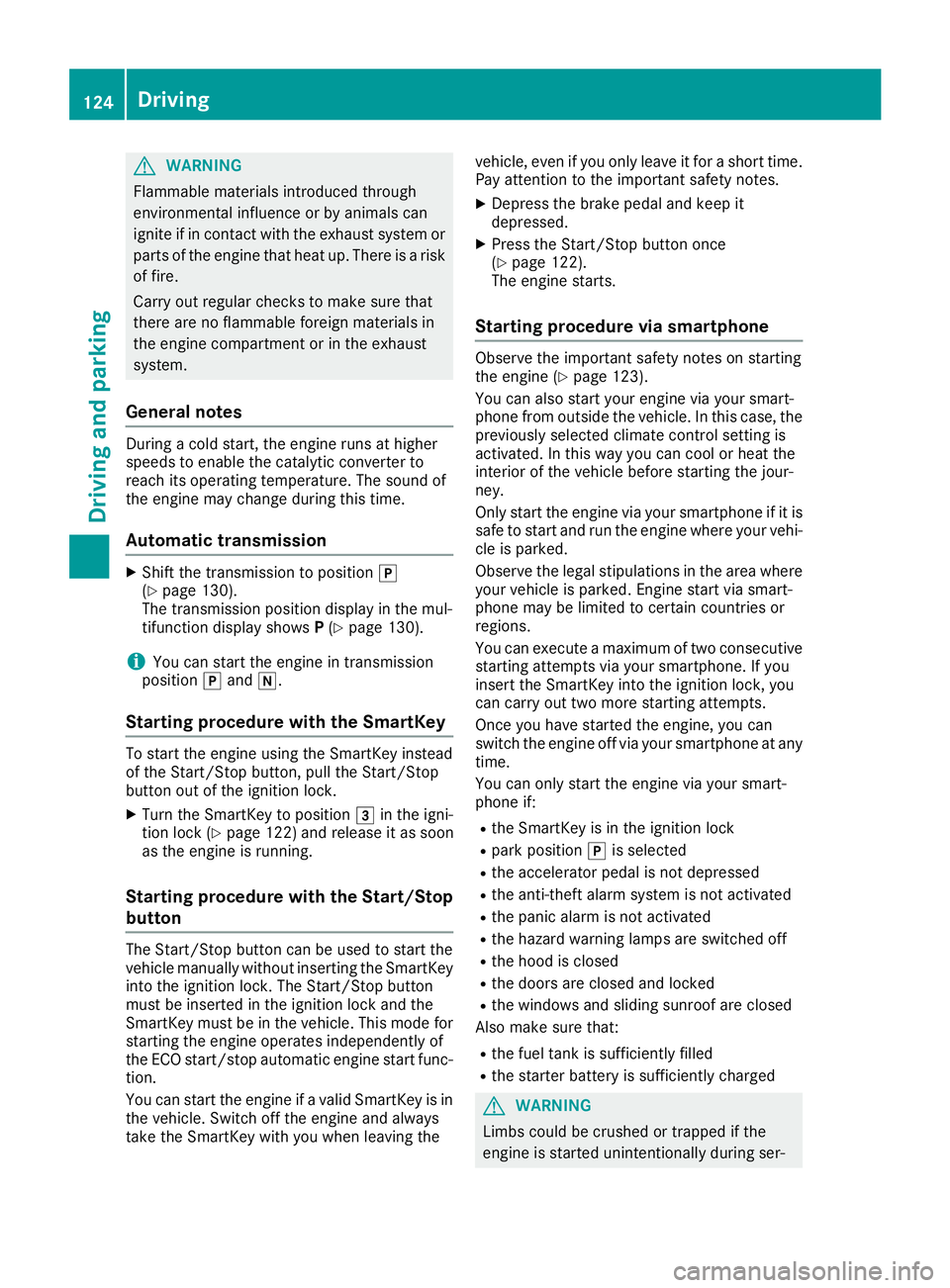
GWARNING
Flammable materials introduced through
environmental influence or by animals can
ignite if in contact with the exhaust system or
parts of the engine that heatu p. There isarisk
of fire.
Carry out regular checks to make sure that
there are no flammable foreignm aterials in
the engine compartment or in the exhaust
system.
General notes
During acold start, the engine runs at higher
speeds to enabl ethe catalytic converter to
reach its operating temperature. The sound of
the engine may change during this time.
Automatic transmission
XShift the transmission to position j
(Ypage1 30).
The transmission position display in the mul-
tifunction display shows P(
Ypage1 30).
iYou can start the engine in transmission
position jand i.
Starting procedure with the SmartKey
To start the engine using the SmartKey instead
of the Start/Stop button, pul lthe Start/Stop
button out of the ignitio nlock.
XTurn the SmartKey to position 3in the igni-
tion lock (Ypage1 22) and release it as soon
as the engine is running.
Starting procedure with the Start/Stop
button
The Start/Stop button can be used to start the
vehiclem anually without inserting the SmartKey
into the ignitio nlock. The Start/Stop button
must be inserted in the ignitio nlock and the
SmartKey must be in the vehicle. This mode for
starting the engine operates independently of
the ECO start/stop automatic engine start func-
tion.
You can start the engine if avalidS martKey is in
the vehicle. Switch off the engine and always
take the SmartKey with you when leaving the vehicle, even if you only leave it for
ashort time.
Pay attention to the important safety notes.
XDepress the brake pedala nd keep it
depressed.
XPress the Start/Stop button once
(Ypag e122).
The engine starts.
Starting procedure via smartphone
Observe the important safety notes on starting
the engine (Ypag e123).
You can als ostart you rengine via you rsmart-
phone from outside the vehicle. In this case, the
previousl yselected climate control setting is
activated. In this way you can cool or heat the
interior of the vehicleb efore starting the jour-
ney.
Only start the engine via you rsmartphone if it is
safe to start and run the engine where you rvehi-
cle is parked.
Observe the legals tipulations in the area where
you rvehicleisp arked.Engine start via smart-
phone may be limited to certain countries or
regions.
You can execute amaximu moftwo consecutive
starting attempts via you rsmartphone. If you
insert the SmartKey into the ignitio nlock, you
can carry out two more starting attempts.
Once you have started the engine, you can
switch the engine off via you rsmartphone at any
time.
You can only start the engine via you rsmart-
phone if:
Rthe SmartKey is in the ignitio nlock
Rpark position jis selected
Rthe accelerator pedalisn ot depressed
Rthe anti-theft alarm system is not activated
Rthe panicalarm is not activated
Rthe hazard warning lamp sare switched off
Rthe hood is closed
Rthe doors are closed and locked
Rthe windows and sliding sunroof are closed
Also make sure that:
Rthe fuel tank is sufficiently filled
Rthe starter battery is sufficiently charged
GWARNING
Limbs coul dbecrushedortrappe difthe
engine is started unintentionally during ser-
124Driving
Driving and parking
Page 127 of 326
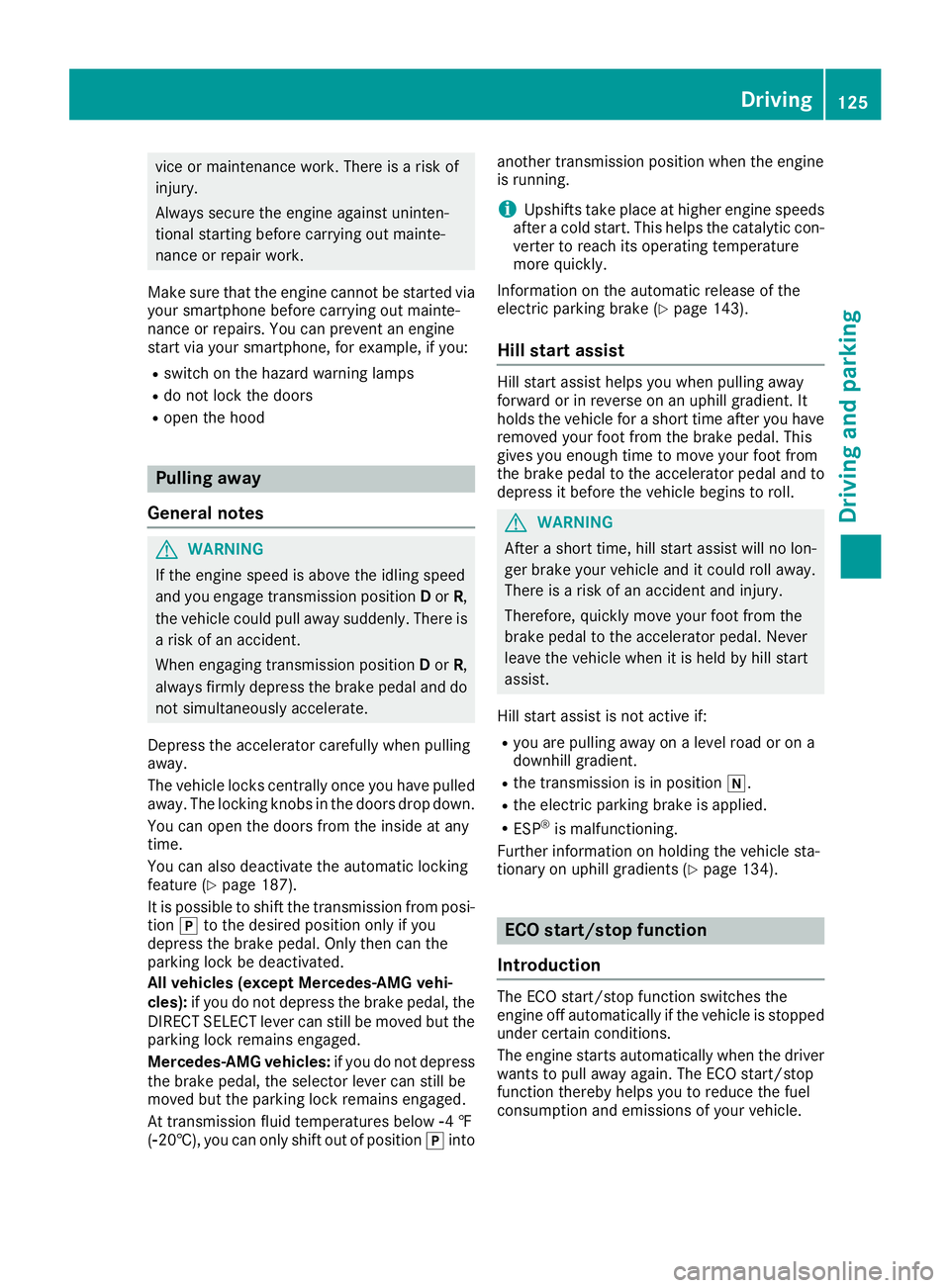
vice or maintenance work. There isarisk of
injury.
Always secure the engine against uninten-
tional starting before carrying out mainte-
nance or repair work.
Make sure that the engine cannot be started via
you rsmartphone before carrying out mainte-
nance or repairs. You can prevent an engine
start via you rsmartphone, for example, if you:
Rswitch on the hazard warning lamps
Rdo not lock the doors
Ropen the hood
Pulling away
General notes
GWARNING
If the engine speedisa bove the idling speed
and you engage transmission position Dor R,
the vehiclec ould pullawa ysuddenly.T here is
ar isk of an accident.
When engaging transmission position Dor R,
alway sfirmly depress the brake pedala nd do
not simultaneously accelerate.
Depress the accelerator carefully when pulling
away.
The vehiclel ocks centrally once you have pulled
away. The locking knobs in the doors drop down.
You can open the doors from the insid eatany
time.
You can als odeactivate the automatic locking
feature (
Ypag e187).
It is possible to shift the transmission from posi-
tion jto the desired position only if you
depress the brake pedal. Only then can the
parking lock be deactivated.
All vehicles (except Mercedes-AMG vehi-
cles): if you do not depress the brake pedal, the
DIRECT SELECT lever can still be moved but the parking lock remains engaged.
Mercedes-AMG vehicles: if you do not depress
the brake pedal, the selector lever can still be
moved but the parking lock remains engaged.
At transmission flui dtemperatures below Ò4‡
(Ò20†), you can only shift out of position jinto another transmission position when the engine
is running.
iUpshifts take place at highere
ngine speeds
after acold start. This helpst he catalytic con-
verter to reach its operating temperature
more quickly.
Information on the automatic release of the
electric parking brake (
Ypag e143).
Hill start assist
Hill start assist helpsy ou when pulling away
forward or in reverse on an uphill gradient. It
holdst he vehiclef oras hort time after you have
removed you rfoot from the brake pedal. This
gives you enoug htime to move you rfoot from
the brake pedaltot he accelerator pedala nd to
depress it before the vehicleb egins to roll.
GWARNING
After ashort time, hill start assist wil lnolon-
ger brake you rvehiclea nd it coul droll away.
There is arisk of an accident and injury.
Therefore, quickly move you rfoot from the
brake pedaltot he accelerator pedal. Never
leave the vehiclew hen it is held by hill start
assist.
Hill start assist is not active if:
Ryou are pulling awa yonalevel road or on a
downhill gradient.
Rthe transmission is in position i.
Rthe electric parking brake is applied.
RESP®is malfunctioning.
Further information on holding the vehicles ta-
tionary on uphill gradients (
Ypag e134).
ECOs tart/stop function
Introduction
The ECO start/stop function switches the
engine off automatically if the vehicleiss topped
under certain conditions.
The engine starts automatically when the driver
wants to pul lawa ya gain. The ECO start/stop
function thereby helpsy ou to reduce the fuel
consumptio nand emissions of you rvehicle.
Driving125
Driving and parking
Z
Page 128 of 326
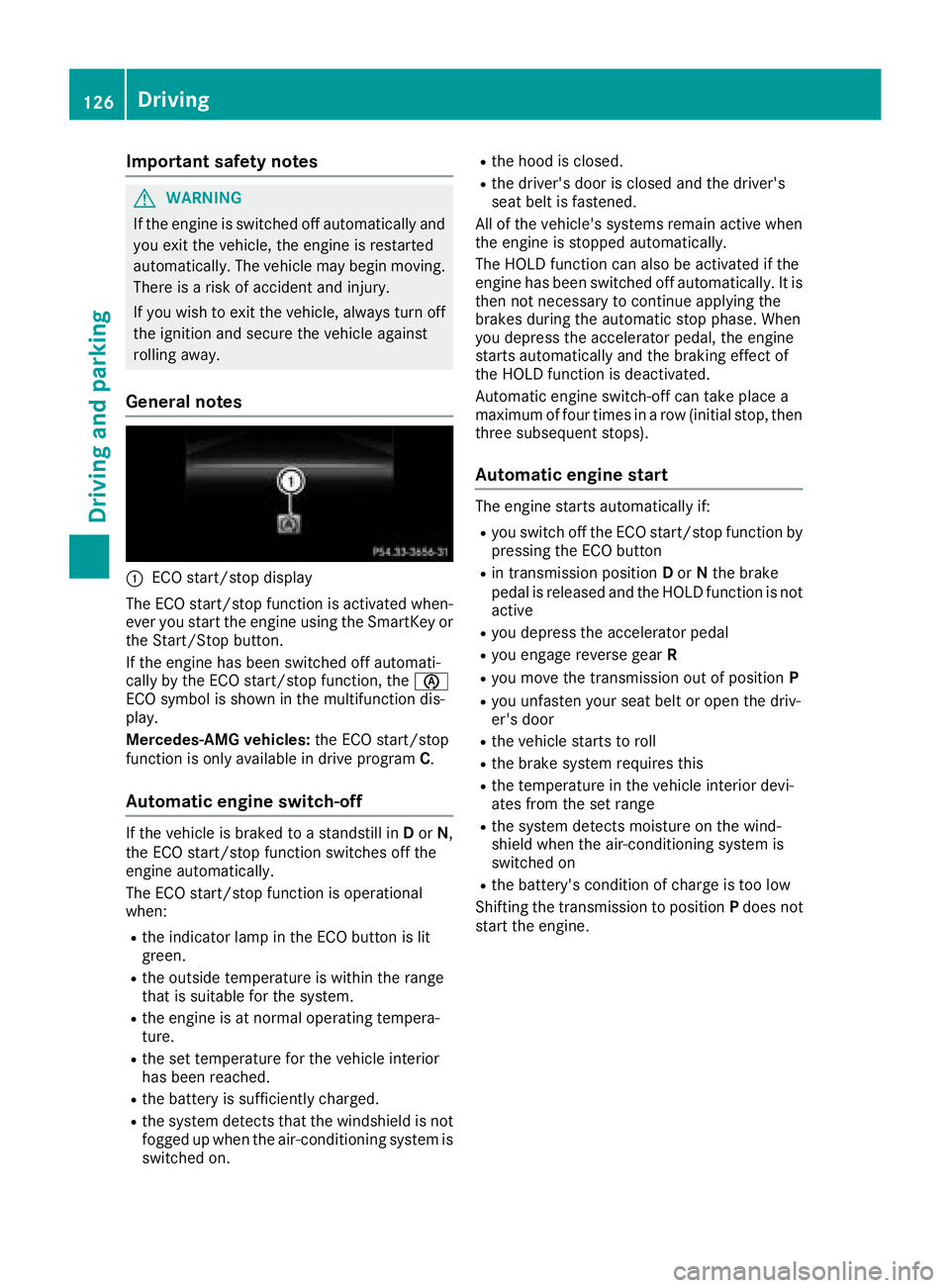
Important safety notes
GWARNING
If th eengineiss witched off automatically and
you exit th evehicle, th eengineisr estarte d
automatically. The vehicl emay begi nmoving .
Ther eisar iskofa cciden tand injury.
If you wish to exit th evehicle, always tur noff
th ei gnition and secure th evehicl eagainst
rollin gaway.
General notes
:ECO start/sto pdisplay
The ECO start/sto pfunction is activated when -
eve ryou start th eengineu singthe SmartKey or
th eS tart/Sto pbutton.
If th eengineh as been switched off automati-
call ybyt heECO start/sto pfunction ,the è
ECO symbol is shown in th emultifunction dis-
play.
Mercedes-AM Gvehicles: theE CO start/sto p
function is only available in driv eprogram C.
Automati cengines witch-off
If thevehicl eisb raked to astandstill in Dor N,
th eE CO start/sto pfunction switches off th e
engin eautomatically.
The ECO start/sto pfunction is operational
when :
Rthei ndicator lamp in th eECO butto nislit
green .
Rtheo utside temperature is within th erange
that is suitable for th esystem.
Rthee ngineisatn ormaloperating tempera-
ture.
Rth es et temperature for th evehicl einterior
has been reached.
Rth eb attery is sufficientl ycharged.
Rthes ystem detects that th ewindshield is no t
fogged up when th eair-conditioning system is
switched on .
Rtheh oodisc losed.
Rthed river' sdoor is closed and th edriver' s
seat belt is fastened.
All of th evehicle's systems remain active when
th ee ngineiss toppe dautomatically.
The HOLD function can also be activated if th e
engin ehas been switched off automatically. It is
then no tneces sarytoc ontin ue applyin gthe
brakes during th eautomatic stop phase. When
you depress th eaccelerato rpedal ,the engin e
start sautomatically and th ebraking effec tof
th eH OLDf unction is deactivated.
Automatic engin eswitch-off can tak eplacea
maximum of four times in arow (initial stop, then
three subsequen tstops).
Automati cengines t art
The enginestartsa utomatically if:
Ryou switch off th eECO start/sto pfunction by
pressin gthe ECO butto n
Rin transmission position Dor Ntheb rak e
pedal is release dand th eHOLDfunction is no t
active
Ryou depress th eaccelerato rpedal
Ryou engage revers egear R
Ryou mov ethe transmission out of position P
Ryou unfasten your seat belt or open th edriv-
er' sd oor
Rthev ehicl estartstor oll
Rth eb rak esystem require sthis
Rth et em perature in th evehicl einterior devi-
ate sfromt heset range
Rthes ystem detects moisture on th ewind-
shield when th eair-conditioning system is
switched on
Rth eb attery's condition of charge is to olow
Shifting th etransmission to position Pdoes no t
start th eengine.
126Driving
Driving and parking
Page 132 of 326
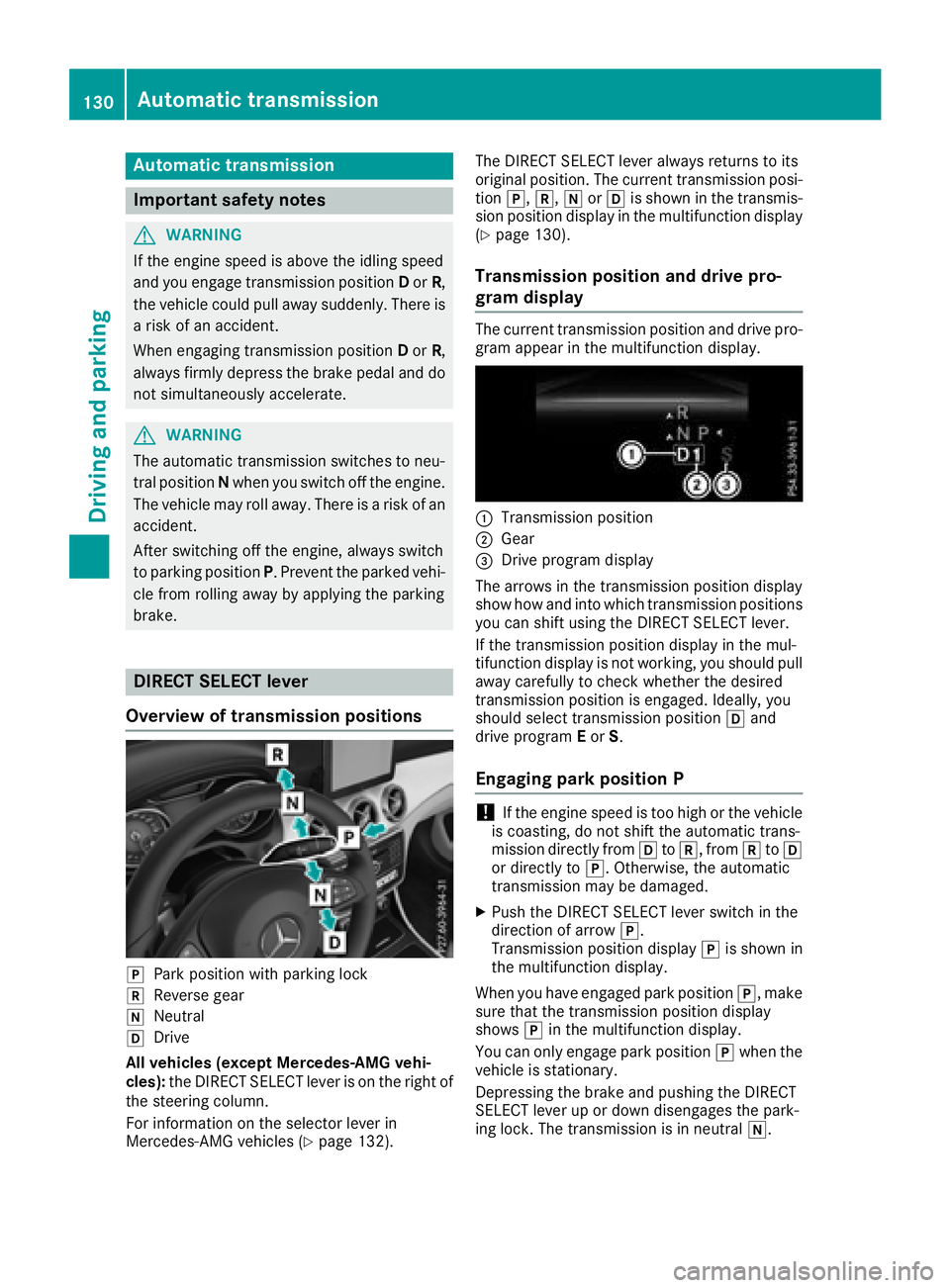
Automa tict rans mi ssion
Import ant safety notes
GWARNIN G
If th eengines pee disa bovethe idlin gspee d
and you engage transmission position Dor R,
th ev ehicl ecould pull away suddenly. There is
ar iskofana ccident.
When engagin gtransmission position Dor R,
always firmly depress th ebrak epedal and do
no tsimultaneously accelerate .
GWARNING
The automatic transmission switches to neu-
tral position Nwhen you switch off th eengine.
The vehicl emay rol laway. There is ariskofa n
accident.
Afte rswitching off th eengine, always switch
to parking position P.Preven tthe parked vehi-
cle from rollin gaway by applyin gthe parking
brake.
DIRECT SELECT lever
Overview oftrans mission positions
jPark position wit hparking loc k
kReverse gear
iNeutral
hDrive
All vehicles (excep tMercedes-AMG vehi-
cles): theD IRECT SELECT lever is on th eright of
th es teering column .
Fo rinformation on th eselector lever in
Mercedes-AM Gvehicles (
Ypage 132). The DIRECT SELECT lever always return
stoits
original position .The curren ttransmission posi-
tion j,k, iorh is shown in th etransmis -
sion position display in th emultifunction display
(
Ypage 130).
Trans mission position and drive pr o-
gram display
The curren ttransmission position and drive pro -
gram appear in th emultifunction display.
:Transmission position
;Gear
=Drive program display
The arrows in th etransmission position display
sho whow and int owhichtransmission position s
you can shif tusin gthe DIRECT SELECT lever.
If th etransmission position display in th emul-
tifunction display is no tworking ,you should pull
away carefully to chec kwhether th edesired
transmission position is engaged. Ideally, you
should select transmission position hand
drive program Eor S.
Engaging pa rkposition P
!If th eengines pee dist oohigh or th evehicl e
is coasting ,donotshif tthe automatic trans -
mission directl yfrom h tok,f rom k toh
or directl ytoj.O therwise ,the automatic
transmission may be damaged.
XPush th eDIRECT SELECT lever switch in th e
direction of arrow j.
Transmission position display jis shown in
th em ultifunction display.
When you hav eengage dpark position j,make
sur ethatthe transmission position display
shows jin th emultifunction display.
You can only engage park position jwhen th e
vehicl eisstationary.
Depressing th ebrak eand pushing th eDIRECT
SELECT lever up or down disengages th epark -
ing lock. The transmission is in neutral i.
130Automatic transmission
Driving andparking
Page 133 of 326

At transmission fluid temperaturesbelow Ò4‡
( Ò20 †),y oucan onlys hift outofp arkp osition
j into another transmission positio nwhent he
engine is running.
In order to shift from park position jdirectly
into korh:
Rdepress the brake peda land
Rpush the DIRECT SELECTl ever up or down
past the first point of resistance
Engagin gpark position Pautomatically
Park position jis automaticall yengaged if:
Ryous witch off the engine using the SmartKey
and remove the SmartKey
Ryo us witch off the engine using the SmartKey
or using the Start/Stop button and open the
driver's door or front-passenger door
Ryo uo pent he driver's door when the vehicl eis
stationar yorwhend riving at averyl ow speed
and the transmission is in position hork
Unde rcertain conditions, the automatic trans-
mission shifts to transmission position jauto-
maticall yifthe HOLD functio norDistance Pilot
DISTRONICi sactivated.O bservethe informa-
tio nont he HOLD functio n(
Ypage 157)and
Distance Pilo tDISTRONIC(Ypage 154).
Engagin grevers egearR
!Onlym ove the automatic transmission to
k when the vehicl eisstationary.
XDepres sthe brake and kee pitpressed.
XPush the DIRECT SELECTl ever up past the
first point of resistance.
The ECO start/stopf unctio nisn ot available
when revers egearise ngaged .Further informa-
tio nont he ECO start/stopf unction
(
Ypage 126).
Shiftin gtoneutral N
GWARNING
If children ar eleftu nsupervised in the vehicle,
they could:
Ropen the doors,t husendangering other
people or roadu sers.
Rget outa nd disrupt traffic.
Roperate the vehicle's equipment.
Additionally, children could set the vehicl ein
motion if, for example, they:
Rrelease the parking brake.
Rshifting the automatic transmission outo f
park position P
RStartthe engine.
There is ariskofana ccident and injury.
Whe nleavi ng the vehicle, always take the
SmartKeyw ithy ou and lock the vehicle. Never
leav echildren or animals unattended in the
vehicle. Alway skeept he SmartKeyo utof
reach of children.
XIf the transmission is in position hork:
push the DIRECT SELECTl ever up or down to
the first point of resistance.
XIf the transmission is in position j:depress
the brake peda land push the DIRECT SELECT
lever up or down to the first point of resist-
ance.
If yo uswitch the engine off with the transmis-
sion in position korh,t he automatic trans-
mission shifts to iautomatically.
With the SmartKey: if youthen open the driv-
er' sd oorort he front-passenger door or remove
the SmartKeyf rom the ignition, the automatic
transmission shifts to jautomatically.
With the Start/Stopb utton:if youthen open
the driver's door or the front-passenger door,
the automatic transmission shifts to jauto-
matically.
If yo uwantthe automatic transmission to
remai ninneutral i,e.g.w he
n
h aving the vehi-
cle cleane dinanautomatic car wash with a
towing system:
XVehicles with the Start-Stop button:
remove the Start-Stop button from the igni-
tio nlock.
XInsert the SmartKeyi nto the ignition lock.
XAllv eh icles: switch the ignition on.
XDepres sthe brake peda land kee pit
depressed.
XEngage neutral i.
XReleasethe brake pedal.
XReleas ethe electri cparking brake.
XSwitch off the ignition and leav ethe SmartKey
in the ignition lock.
Automatict ransmission131
Driving andparking
Z
Page 134 of 326

Engaging drive position D
XIf thetransmission is in position kori:
push th eDIRECT SELECT leve rdown past the
first pointofr esistance.
XIf thetransmission is in position j:depress
th eb rak epedal and push th eDIRECT SELECT
leve rdown past th efirst pointofr esistance.
Selector lever (Mercedes-AMG vehi-
cles)
Overview of transmission positions
jPark position with parking lock
kReverse gear
iNeutral
hDrive
Transmission position and drive pro-
gram display
The curren ttransmission position and driv epro-
gram appear in th emultifunction display.
:Transmission position display
;Drive program display
If th etransmission position display in th emul-
tifunctio ndisplay is no tworking ,you shouldp ull
away carefully to check whether th edesired
transmission position is engaged. Ideally, you
should selectt ransmission position hand
driv eprogram Cor S.
Engaging park position P
XWhen th evehicle is stationary, pres sbut-
ton :.
Engaging revers egear R
!Only mov ethe automatic transmission to
k when th evehicle is stationary.
XDepres sthe brak eand keep it pressed.
XPush th eselecto rleve rforwards past th efirst
pointofr esistance.
132Automatic transmission
Driving and parking
Page 135 of 326
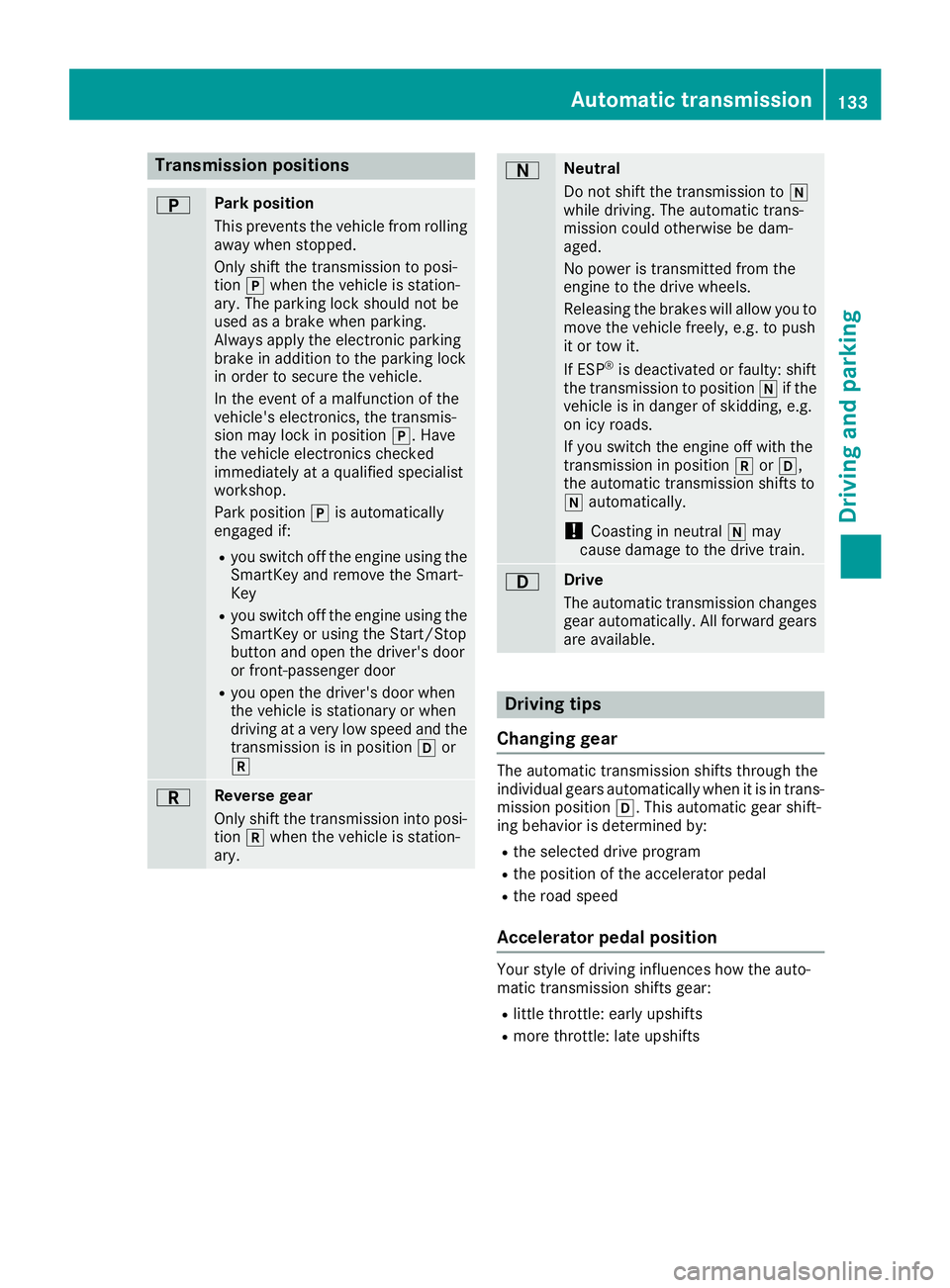
Transmission positions
BPark position
Thisprevents the vehicl efromr olling
away when stopped.
Onlys hift the transmission to posi-
tion jwhen the vehicl eisstation-
ary. The parkin gloc ks houl dnot be
used as abrake when parking.
Alway sapply the electronic parking
brake in additio ntothe parkin gloc k
in order to secur ethe vehicle.
In the event of amalfunctio nofthe
vehicle's electronics ,the transmis-
sion mayl ockinp osition j.H ave
the vehicl eelectronics checked
immediatel yataqualified specialist
workshop.
Park position jis automatically
engaged if:
Ryo us witch off the engine using the
SmartKeya nd remove the Smart-
Key
Ryo us witch off the engine using the
SmartKeyoru sing the Start/Stop
button and open the driver's door
or front-passenge rdoor
Ryouo pent he driver's door when
the vehicl eisstationar yorwhen
drivin gatav eryl ow spee dand the
transmission is in position hor
k
CRevers egear
Onlys hift the transmission into posi-
tion kwhen the vehicl eisstation-
ary.
ANeutral
Do not shift the transmission to i
whil edriving. The automatic trans-
mission could otherwis ebedam-
aged.
No powe ristransmitted fromt he
engine to the drive wheels.
Releasing the brakes will allo wyouto
mov ethe vehicl efreely, e.g .topush
it or tow it.
If ESP
®is deactivated or faulty: shift
the transmission to position iif the
vehicl eisind angerofs kidding,e.g.
on icy roads.
If yo uswitch the engine off with the
transmission in position korh,
the automatic transmission shifts to
i automatically.
!Coasting in neutral imay
cause damage to the drive train.
7Drive
The automatic transmission changes
gear automatically. All forward gears
ar ea vailable.
Driving tips
Changin ggear
The automatic transmission shifts throug hthe
individual gear sautomaticall ywhenitisint rans-
mission position h.Thisa utomatic gear shift-
ing behavio risdetermine dby:
Rthe selecte ddrive program
Rthe positio nofthe accelerator pedal
Rthe roa dspeed
Accelerator peda lposition
Your style of drivin ginfluences how the auto-
matic transmission shifts gear:
Rlittle throttle :early upshifts
Rmor ethrottle :lat eu pshifts
Automati ctransmission133
Driving an dparking
Z